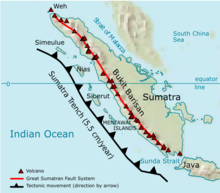Accretion wedge
An accretion (from Latin: accretio "increase") or accretion wedge is a geological structure that arises in the course of plate tectonic processes during the subduction of oceanic crust on the front (English forearc ) of the upper, crossing lithospheric plate . It arises from the accretion (accumulation) of sediments , in some cases also of oceanic crust, and is characterized by strong deformation of the accreted material, which is broken up by countless thrusts .
Emergence
Along the plate boundary, at which the denser plate is subducted, a deep furrow forms under the upper plate due to its kinking, which is referred to as a deep sea channel . Towards the side of the upper, underrun plate, enormous mechanical pressure and friction forces act in the area of the deep sea channel due to the collision of the two earth plates. These lead to the fact that the sea sediments and in some cases also layers of the oceanic crust ( autopsy ) are planed from the submerged plate and attached in a wedge-shaped accumulation under the edge of the upper plate (tectonic underplating). Sediment masses often detach from the forehead of this accumulation and are shifted by mud flows ( Olistho flow ), landslides and turbidites into the upstream deep sea channel, where these sediments are referred to as flysch after they have solidified .
plate tectonics
Accretion wedges are typically found at destructive plate boundaries such as island arches and plate boundaries of the cordilleras or Andes type. They often occur in connection with other structures that are created by the subduction process. The overall system has the following elements: outer swell or bulge - accretionary prism - arc-trench gap or forearc - island arch or continental margin - back arc area or marginal basin ( Backarc basin , marginal basin ).
Accretion wedges on island arches

Island arcs are structures that occur as a result of plate tectonics. They arise where two oceanic lithospheric plates move towards each other and eventually subduction occurs. One of the two lithospheric plates - usually the older of the two, as it usually has already cooled down more and therefore has a higher specific density - is "pressed" under the other and forced to submerge into the earth's mantle .
The accretion wedge is in front of the actual island arch as a kind of outer threshold, which, however, has nothing to do with island arch volcanism. Depending on the accretion rate, i.e. the rate of growth, and the depth of the sea, the accretion wedge can rise above the sea surface.
literature
- Klaus Strobach (1991): Our Planet Earth , Gebr. Borntraeger, Berlin, pp. 186
Individual evidence
- ^ Jean-Pierre Burg: Large-scale structures and plate tectonics. Teaching material from the Structural Geology and Tectonics group, ETH Zurich ( Memento from February 1, 2012 in the Internet Archive ) (PDF; 1.5 MB)
